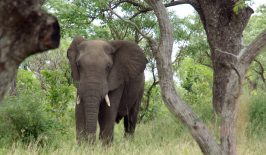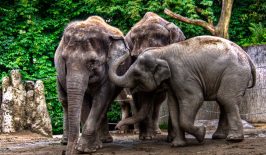The national and regional lockdowns imposed in the wake of the coronavirus crises has clearly resulted in a major disruption to the daily lives of billions of people. However, for the world’s wildlife, the slowdown in human activity may have presented an unusual opportunity.
A UK team, headed up by the University of St Andrew’s School of Biology professor Christian Rutz, recently published an article in Nature, Ecology and Evolution which included recommendations for how conservationists and biodiversity researchers can best exploit this period. In particular, it is felt that this moment – referred to by the team as the ‘anthropause’ – could help both humanity and wildlife share an increasingly crowded Earth in the future.
Anecdotal evidence has suggested that restrictions on movements, industry and economic activity in certain areas has led to a sudden increase in the presence of wildlife, especially in urban areas. Videos began to emerge on social and news media of various species appearing in seemingly unusual areas, such as goats in towns in North Wales and jackals in Tel Aviv’s parks.
In reality, many of these social media posts – especially in regards to dolphins and swans in Venice – are perhaps not entirely accurate, with National Geographic going as far to label them as ‘fake news’. Indeed, one reason people may be seeing more wildlife is because, paradoxically in a ‘lockdown’, more people are enjoying parks and green spaces. Meanwhile, some daylight sightings of urban animals, such as foxes and jackals, is likely not due to them ‘returning’ to areas they had been pushed out from, but due to a lack of food that was previously provided from human sources. In this sense, the lockdown may be detrimentally affecting some urban species.
Regardless of the accuracy of these claims, it has become clear animals and humans are now living closer than ever and are increasingly interdependent. What is needed now, claims Rutz and his colleagues, is a robust quantitative assessment of animal movement and behaviour during this period. It is hoped it could provide valuable insight into future conservation efforts.
Tracking Wildlife in the 21st Century
The team suggests that at the forefront of this endeavour should be new technologies, including so-called “bio-loggers”. Rudimentary trackers, such as radio collars, have been used for decades, however more modern versions, like satellite collars, can provide unprecedented insight into the daily lives of wildlife. Larger animals were usually the best candidates for such a study, however as Dr Steve Portugal, a comparative ecophysiologist at Royal Holloway, University of London, told RESET, their increased miniaturization allows for new possibilities:
“As technological advances permit bio-logging devices to become smaller, this opens up windows of opportunity to study species that were previously off limits due to their small size and weight. Bio-loggers have now been successfully deployed on bats, small passerine birds and flying insects. Knowing where animals go and what they are doing where they are is pivotal, for example, for maintaining and protecting important habits and sites.”
Newer sensors are not able to track an animal’s location, but also read information of increased sophistication regarding a subject’s behaviour and general physiology. For example, bio-loggers attached to sea turtles can constantly read water temperature and pressure, showing the depths which sea turtles can dive. Additionally, a dry/wet sensor can also indicate where and when sea turtles leave the ocean to lay eggs.
Bio-loggers can therefore provide a series of advantages over more traditional methods, which often relied on physically locating and observing the animal in question. Although in some cases bio-loggers need to be eventually retrieved, their long battery life – up to years in some cases – means they can provide much more consistent information than normal human observation. Ultimately, they also have an economic advantage and are cheaper and easier in the long-run than observational expeditions on the ground.
Currently, there are many different initiatives of varying sizes underway across the globe, some of which can be seen on Movebank.org, a free online database of animal tracking sensors. Professor Rutz, who is also president of the International Bio-logging Society, has called for even more increased cooperation at this time to fully assess the impact of the anthropause on wildlife from a wide range of sources. According to the above-mentioned article, his call has already resulted in enthusiastic support from across the bio-logging community.
However, bio-logging may potentially come with a downside. According to Dr Portugal, it has been suggested that the attachment of bio-loggers could affect offspring quality, energy expenditure and survival rate of individual animals, especially in regards to flying and diving species. To this end, researchers also need to take extensive care to ensure bio-loggers are attached in a responsible manner and only to those animals for which they are suitable. When done in such a way, the impact upon some species should be near non-existent.
Despite this, conservationists have also been experimenting with other methods of tracking and identifying animals in the wild that do not require physically attaching a sensor to the animal. Previously, RESET has covered the use of audio sensors, image recognition software and artificial intelligence in tracking and identifying species and individual animals. As these kinds of technologies develops, it is hoped that they could also be used to assess the health and behaviour of animals, albeit in a more static way than bio-loggers, with very little disruptive impact to the animals and their natural habitat.





